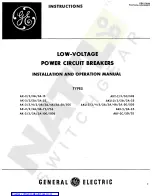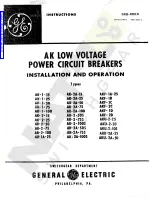Reviews:
No comments
Related manuals for AKR-60-75

AK-2-15
Brand: GE Pages: 10

AK-1-15 Series
Brand: GE Pages: 7

BZM3 SIMPLE
Brand: Eaton Pages: 4

Polaris 1500
Brand: DAE Controls Pages: 14

EKBPR2A81
Brand: Daikin Pages: 2

ISM Shell_2 Series
Brand: TAVRIDA ELECTRIC Pages: 83

Masterpact MP
Brand: Merlin Gerin Pages: 80

HD4/ESB Series
Brand: ABB Pages: 42

Z-SH
Brand: Eaton Pages: 2

XTPE(A)036BCSNLSOND533 Series
Brand: Eaton Pages: 2

XTCC012C Series
Brand: Eaton Pages: 2

Z-ASA
Brand: Eaton Pages: 2

















